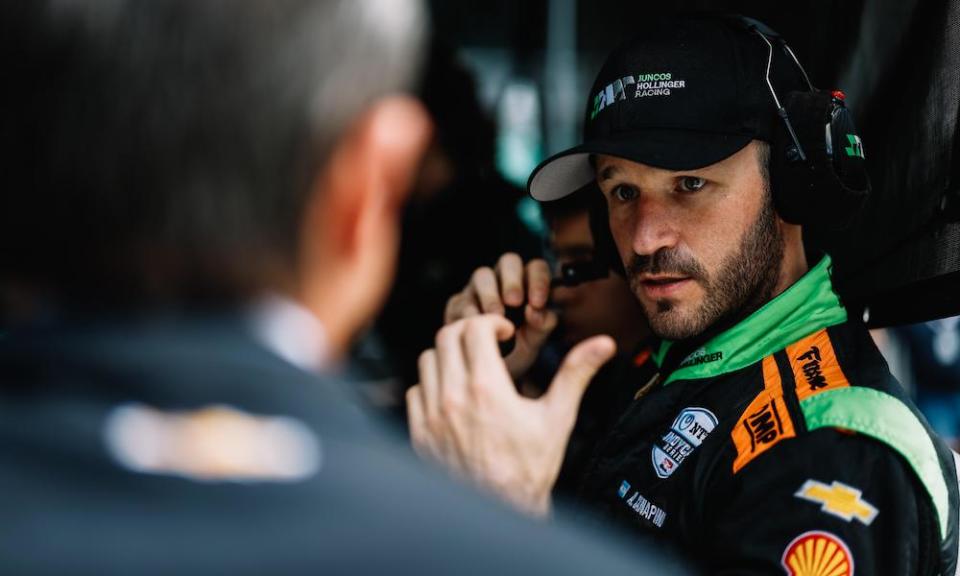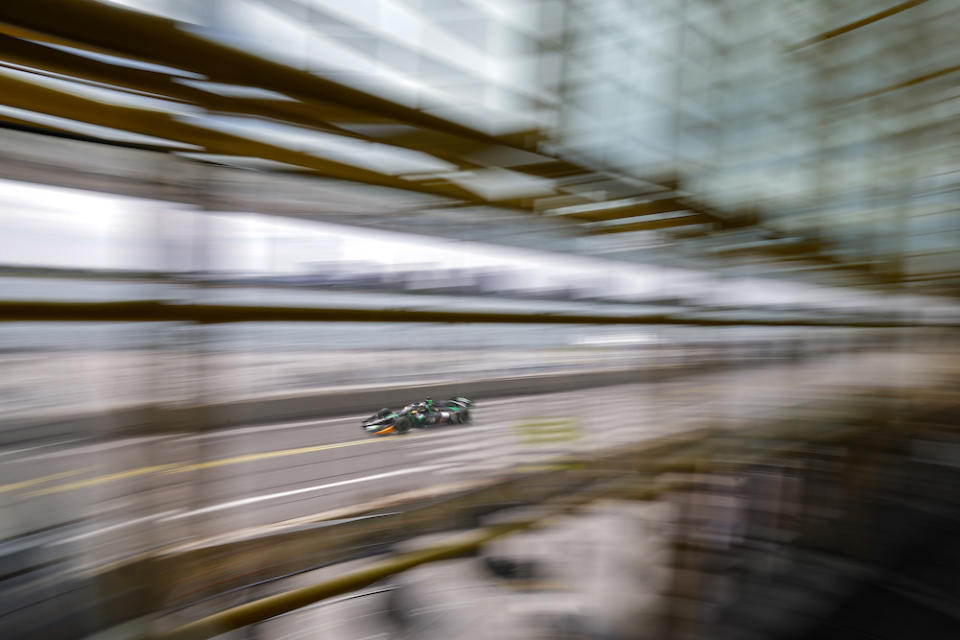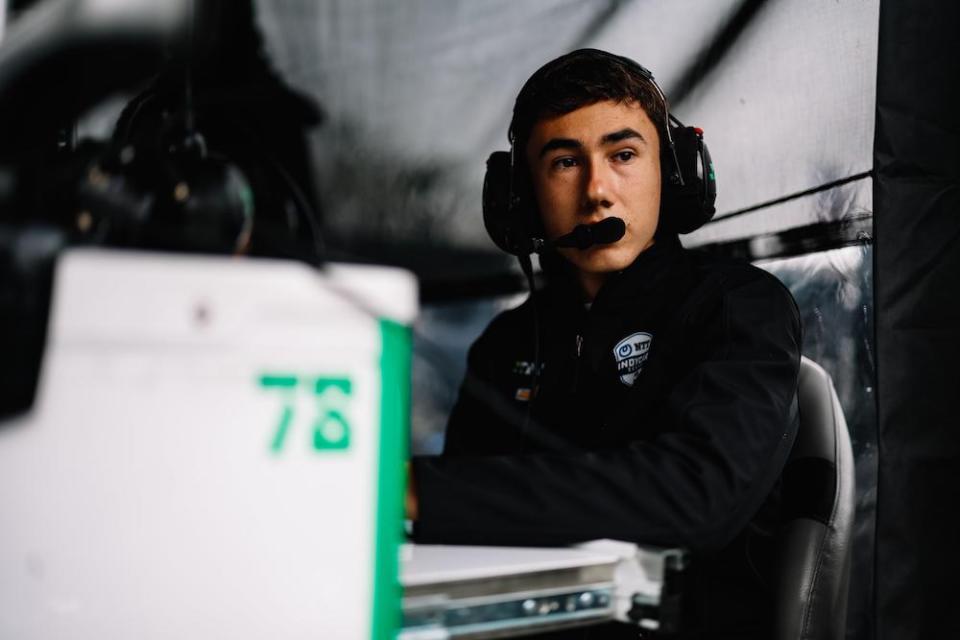Juncos Hollinger was right to bench Canapino – but what happens next?

Juncos Hollinger Racing made the right decision to pull Agustin Canapino from its car for last weekend’s NTT IndyCar Series race in Road America.
Team sources point to the Argentinian reaching an increasingly distracted mental state as the opening practice session drew near at 2:45pm on Friday. Although he was seen in a lighthearted mood in the morning, his disposition darkened in the hours that followed, and with the inherent dangers of racing at 200mph, the team — not IndyCar, but the team — chose to give the 34-year-old Canapino a break. But there was a lot more to the story.
It was clear that trying to power through the emotionally-charged events that followed the previous weekend’s race in Detroit was not the right approach to take. Giving Canapino time to process and purge the mounting anger he was demonstrating both privately and in his public behavior online became the new priority for JHR, so it acted accordingly.
An ugly side of humanity has been evident on social media throughout the three incidents sparked by a subset of Canapino’s fans. That small group has sent death threats and menacing messages through direct messagess and some public posts in 2023 to Canapino’s former teammate Callum Ilott, whose relationship with the team devolved. Despite having another year on his contract, they split as a result of the handling of the April and September attacks on the Briton.
For a third time in 14 months, the death threats from Canapino supporters were directed at another driver in Arrow McLaren’s Theo Pourchaire. The attacks came after he hit and passed Canapino at Detroit, which led to a penalty from IndyCar that required the Frenchman to surrender three positions. Pourchaire finished 10th and Canapino placed 12th. The threats began filling the 20-year-old’s inbox after the race and kept coming in the days prior to Road America.
In a saddeningly predictable reaction, Canapino treated the new death threats as he did the previous ones: with doubt and contempt. He questioned the authenticity of Pourchaire’s claim, just as the claims around his former teammate were disbelieved, and effectively dismissed.
A newer twist has emerged surrounding the Pourchaire incident with a notable social media pushback aimed at Canapino. Although he’s been catching hell for the actions of his fans and his poor choice to press the ‘like’ button on some mocking and critical posts about Pourchaire, the part that enraged Canapino was the blaming of South Americans — and Argentinians, specifically — for all of the nasty messages. The stereotyping has not been well-received by the JHR driver nor his team, and nor should it be as no single country or geographical region can be held responsible.

Canapino was unhappy that Argentinian fans were collectively blamed for the bad behavior of a small group, but his position within JHR was undermined by his personal disdain for the threats made against Pourchaire after Detroit. Brett Farmer/Motorsport Images
Canapino’s hardened stance on the latest clash only served to isolate him within the team, which is another factor in his being parked. Taking to social media on his own — independent of the JHR team — Canapino was combative, veered towards victim-blaming, and suggested Pourchaire, like Ilott, just needed to be strong and ignore the negativity. His deflective statements only made matters worse.
But the gravity of the week’s exchanges, and the receiving of hate-filled messages fired in his direction, finally broke through his defenses and took Canapino to a bad place; in the team’s eyes, driving a race car at Road America was the last thing he needed to worry about. Placing Canapino’s mental health first was an extraordinary decision by JHR; most drivers wouldn’t volunteer to step out of the cockpit out of fear for being seen as weak or scared. JHR took that call out of his hands, which was brave in knowing it would lead to another volley of criticism, but deserves respect.
Also, the team was looking for an expression of compassion or remorse from Canapino as Road America approached — a demonstration that he was starting to defuse and reduce the intensity of the situation — but it wasn’t forthcoming. This also factored into the team’s move to place Indy NXT title contender and budding IndyCar racer Nolan Siegel in Canapino’s No. 78 Chevy.
Another facet to acknowledge is how, after doing little to aggressively fight back against the three separate attacks, Canapino and JHR haven’t made any progress in preventing future attacks. Due to their shared indifference to the attacks, no message of any weight or strength has been communicated to that subset of fans who’ve caused the problems.
Any driver in IndyCar who makes contact – or somehow interferes with – Canapino is at risk of being the next victim. Handled correctly the first time, this might not be as problematic as it has become for the team and the series, but it wasn’t, so the pin is always waiting to be pulled from this hand grenade.
So where does this situation go in the coming weeks? There are some big picture concerns to address within the team.
Co-owner Brad Hollinger made a major investment in Juncos Racing to give the renamed Juncos Hollinger Racing program significant funding to reestablish itself across multiple years, but the team has struggled to secure the annual operating budget it needs to operate. Although Hollinger’s passion for the sport and infusion of money have kept JHR in motion, it needs to generate income for the program to function properly. His partnership with Juncos has never been about paying for everything just for the sake of being involved.
It also makes the timing of the issues with Canapino one where any new opportunities to bring in funding cannot be ignored. Minus the actions and events since Detroit, there was no question as to whether Canapino would finish the season. Even with the mostly bare cars under the JHR awning, Canapino wasn’t at risk of being replaced at any point in 2024. The same cannot be said today.

If JHR decides that Canapino’s place in the team is no longer tenable, Siegel could fill the seat of the No.78, and also the team’s need for additional funding. Joe Skibinski/ IMS Photo
The fascinating scenario sitting in front of JHR and Mark Siegel, Nolan’s father, is where the impromptu relationship could head. The elder Siegel has been artful in how he’s managed his teenaged son’s career; thanks to his extreme success as a venture capitalist, Siegel has been able to make a series of careful moves designed to develop Nolan’s skills in junior open-wheel racing and in domestic and international endurance competition in LMP2 prototypes. Paying for seats and partial or full seasons in the USF Championships, Indy NXT, IMSA, the ELMS, and the WEC have all been used to refine Nolan’s potential.
Siegel also crafted a plan for Nolan to do four IndyCar races this year with Dale Coyne Racing, which had the only part-time program to offer, to prepare his son for going full-time in IndyCar in 2025. Siegel chose just the four races to preserve Nolan’s ability to vie for IndyCar’s Rookie of the Year award.
The Siegels also chose to abandon Nolan’s Indy NXT weekend in order to focus on the No. 78, which suggest they’re already modifying the plan as Siegel’s odds of vying for the NXT title has been diminished.
Depending on where JHR and Canapino end up on his return to the car, the Siegels would be wise to forget the four-race RoY plan and do more races in the No. 78 car, if it’s available. Both sides have been talking, and if Road America serves as Canapino’s final IndyCar race, this could be the break Siegel has been wanting with a bigger team. Most importantly, staying in the No. 78 would be beneficial for Siegel. who would get to continue working with one of the series’ great race engineers in IndyCar championship- and Indy 500-winner Allen McDonald.
JHR’s plight on the sponsorship and commercial sales side also can’t be overlooked. The team, which finished seventh on Sunday with Romain Grosjean in the No. 77 Chevy and brought Nolan home with a clean car in 23rd, can expedite his IndyCar learning curve. In kind, Nolan’s father can certainly help the team with the funding it sorely lacks. Again, the timing of the Canapino situation is concerning because of what might emerge in who gets to drive the No. 78 moving forward.
The team isn’t attending Tuesday’s hybrid powertrain test at the Milwaukee Mile, so JHR isn’t in an immediate rush to resolve its driver dilemma; its next outing is at Laguna Seca — Siegel’s home track — across June 21-23.
And now we enter that awkward phase where the fate of Canapino’s IndyCar career sits unresolved, but he deserves another shot, provided he shows the humility and kinder tone the team is seeking. Without a big budget of his own to offer, no other teams would hire Canapino, so it’s down to whether Juncos and Hollinger want to let him finish the season, or if they’d prefer to start developing a young new prospect in Siegel and fix some of the cracks in the team’s financial foundation.
The amazing story of a living legend of Argentinian touring car racing coming to America to race in open-wheel cars he knew nothing about, and not at the Indy NXT level, but going straight to IndyCar, was phenomenal. Canapino’s talent allowed him to adapt immediately and he soared at his first oval race and mixed with young and old open-wheel veterans alike, running in the top 10 at the season finale in his rookie year.
While his sophomore run hasn’t been as spectacular, the chance to make another step was there for him to take. If we’ve seen the last of Agustin Canapino in IndyCar, it will be a sad end to a once-great story.

 Yahoo Autos
Yahoo Autos 